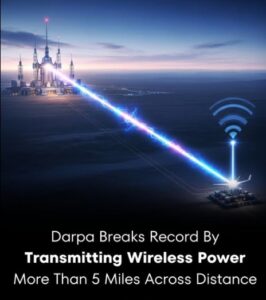DARPA Breaks Ground with Wireless Laser Power Transmission Over 5 Miles
In a groundbreaking experiment that pushes the boundaries of modern energy technology, the U.S. Defense Advanced Research Projects Agency (DARPA) has successfully transmitted over 800 watts of power across a distance of 5.3 miles (8.6 kilometers) using a high-powered laser. The test, conducted in June 2025 in the New Mexico desert, represents a significant step toward truly wireless power transmission on a meaningful scale.

This achievement was part of DARPA’s Persistent Optical Wireless Energy Relay (POWER) program—a project designed to explore the feasibility of transmitting substantial amounts of energy over long distances without the use of cables, power lines, or fuel-dependent infrastructure.
During the demonstration, energy was transferred wirelessly for 30 continuous seconds, totaling more than one megajoule of delivered energy—enough to power several small household appliances at once. This is not just a technological curiosity; it represents a major leap forward with practical implications across defense, humanitarian aid, and potentially even civilian applications.
How Laser-Based Power Transmission Works
The system works through directed-energy transfer: a high-powered laser acts as the medium, projecting energy across vast distances. A specially engineered receiver, designed to convert this laser energy into usable electrical power, captures the beam at the destination.

One of the challenges in such systems has always been maintaining alignment between the transmitter and receiver, as well as minimizing energy loss during the transmission process. DARPA’s experiment demonstrated a remarkably efficient solution to these technical barriers, showing that power can be directed with both accuracy and consistency across miles of open terrain.
Why This Technology Matters
Imagine a future where remote areas devastated by natural disasters can have power restored within hours—not days—without needing fuel or rebuilding infrastructure. Picture military operations that no longer depend on supply convoys carrying fuel, which are often vulnerable in combat zones. Or consider drones that can remain in flight indefinitely, recharging wirelessly while still airborne.
These once far-off concepts are now within reach thanks to the capabilities proven in this DARPA demonstration.
Wireless energy transmission could revolutionize logistics in both military and civilian contexts. In disaster relief efforts, it could be used to energize remote medical stations or communications systems without the need for a grid. In the military, the ability to deploy power instantly to forward-operating bases without physical fuel deliveries enhances operational safety and efficiency.
The Strategic Edge
From a defense perspective, DARPA’s innovation provides a strategic edge by decoupling energy availability from geography. Bases or mobile units deployed in energy-scarce regions can become self-sufficient, with energy relayed from distant hubs via laser. This reduces vulnerability and creates a flexible energy network not bound by physical infrastructure.
Moreover, such systems could be adapted for space exploration. Satellites or planetary missions could use similar beams to power equipment remotely, reducing the need for heavy on-board fuel or large solar arrays.
Challenges Ahead
Despite the major success of this test, challenges remain before the technology becomes widely deployable. Atmospheric interference, beam stability, safety regulations, and energy conversion efficiency must continue to be refined. Precision tracking is essential, especially if the receiver or transmitter is mobile, such as on a drone or a vehicle.
Additionally, widespread adoption would require international cooperation and regulation to ensure that high-powered lasers used for transmission do not interfere with aircraft or harm living organisms. Still, the successful test proves that the core science is sound and the engineering obstacles are solvable.
Beyond Defense: A Glimpse into Civilian Use
While DARPA’s work is defense-focused, the broader implications are immense. In remote villages lacking infrastructure, wireless energy beams could power schools, hospitals, or communication towers. In cities, it might mean fewer cables, faster deployment of power to emerging developments, or backup power when grids fail.
It’s not difficult to imagine a future where vehicles could be powered mid-motion, solar energy collected in one part of the world could be sent elsewhere, or mobile data centers are powered in real-time as they move.
The dream of truly mobile, wireless energy transmission is no longer theoretical—it’s becoming a viable part of tomorrow’s global energy landscape.
Source:
DARPA / U.S. Department of Defense, June 2025 Wireless Power Transmission Report